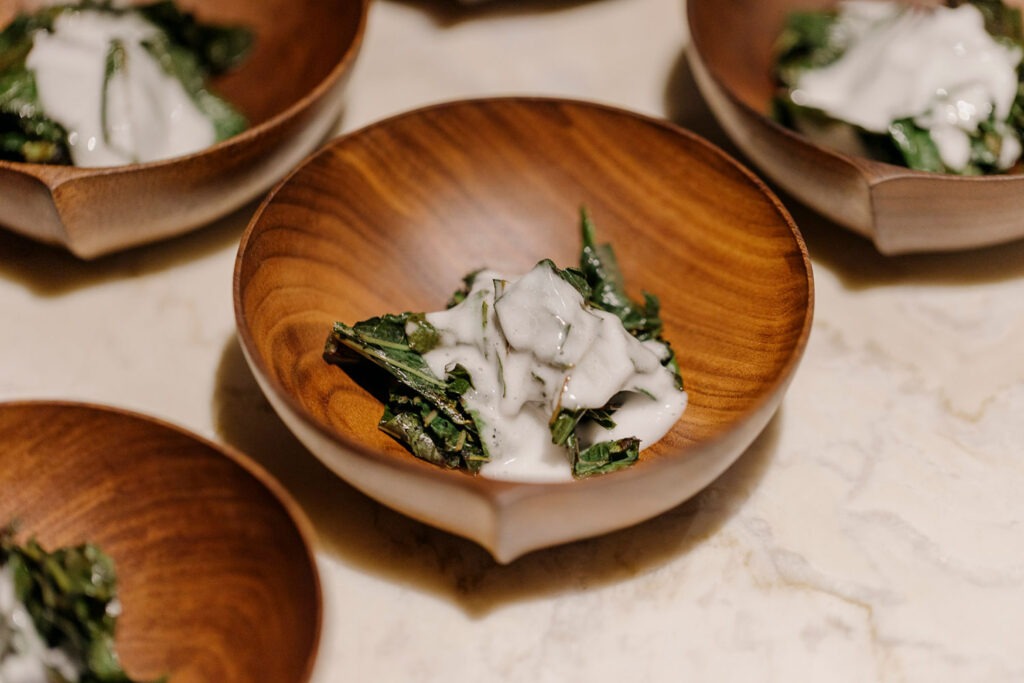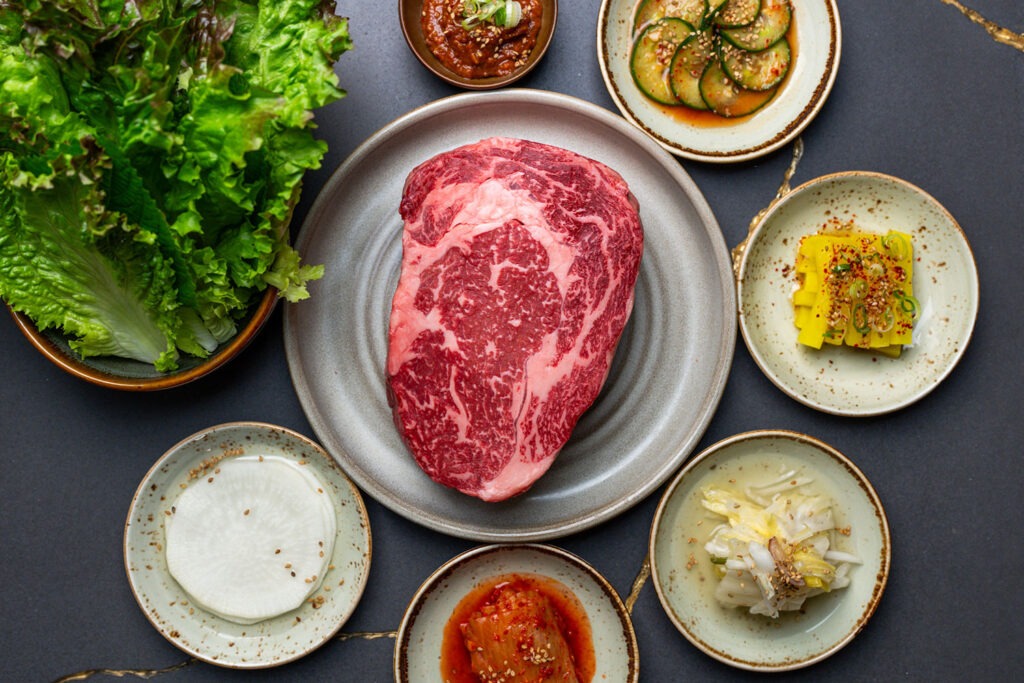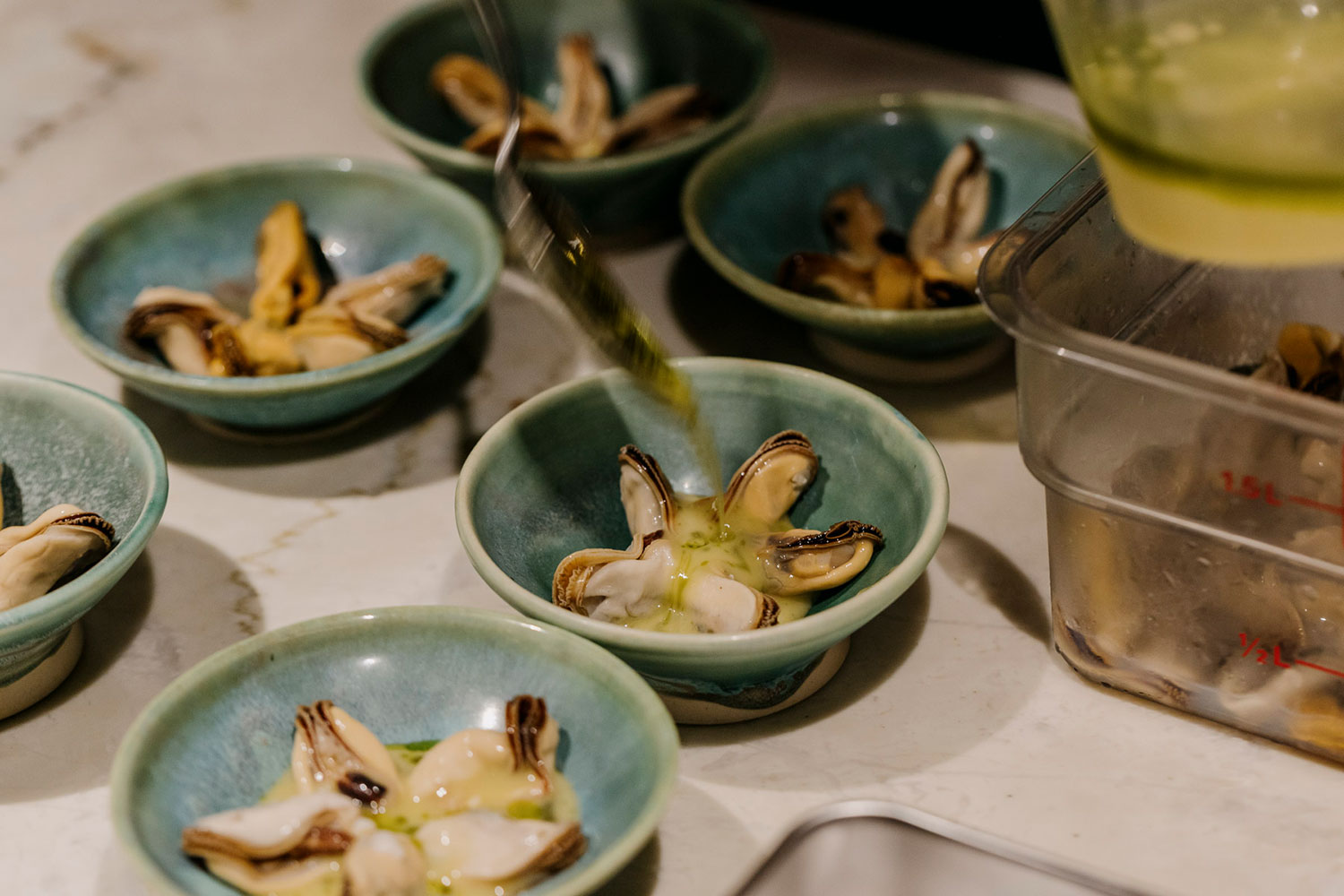
I’m going to say it again (and again, and again, and again): there are a lot of tasting menus in Chicago. This city’s top-level chefs tacitly promise to provide you with a full evening of entertainment, whether you’re an avid follower of the dining scene, a celebrant having a once-a-year splurge, or a food tourist who has Chicago on the short list of must-visit destinations.
There are more tasting menus than we can or should review in this magazine lest we give short shrift to the other 95% of worthy restaurants. Plus, most of them are showcases for a chef’s technical prowess, eye for creating visual drama on a plate, and storytelling as much as their palates. Yet one exception, which I reviewed last month, is the restaurant Feld. Like it (which I very much do) or hate it (which a lot of early visitors did), this Ukrainian Village spot and its chef-owner Jake Potashnick are really trying to do something new enough that it changes the conversation.
I’m writing about it again because the dinners I ate there have persisted vividly in my memory. I had two meals consisting of 30-some small bites at each, and if you asked me to pass a cognitive memory test I could probably describe about 75% of them. I may not be able to rattle off all the ingredients in each dish or the order in which they arrived, but I can tell you how they tasted and how I reacted. The smell of fresh grapes on a wiggly sliver of roasted foie gras, the millefeuille like texture of a grilled artichoke, the weird funk of butter churned from house-cultured cream.
The online publication Understanding Hospitality took a deep-dive look at Feld. Its author, who goes by the pen name Grimod, came to the same conclusion after multiple visits that I arrived at after two, which is that the restaurant continues to raise its batting average of hits to misses. The food has grown more assured and interesting. As regards the early poor reviews, the author called it a “clash of expectations of novel-experiential vs. conventional-hedonistic modes of appreciating fine dining.” Bingo. Do you go to a tasting menu meal to try something unexpected that you won’t find elsewhere, or do you go to revel in luxury ingredients? Or both?
I might take this line of thought a step further by looking backward. In the early days of Alinea and Moto (as well as restaurants like El Bulli, Arzak, and WD-50 elsewhere), this distinction was at its sharpest. Chefs of this era swung the pendulum hard toward experiential dining, and they did so with new technologies, new ideas about how to plate food for maximal impact, and a gleeful desire to explode old orthodoxies that stated what ingredient and flavor combinations were permissible. You went to these restaurants to have every assumption upended. I can still remember a friend coming back from a hard-won reservation at El Bulli and telling me about opening a caviar tin to find it filled with spherified green apple juice pearls. Mind. Blown.

Novel, synapse-scrambling innovations become a bag of tricks over time. Now we help ourselves to spherified pellets of fruit juice at yogurt shops. The novelty had to amp up. Places that still try to push the experiential side to its apotheosis are playing three-dimensional chess and creating immersive environments, such as Vespertine in Los Angeles or the Alchemist in Copenhagen.
Others, like most of the tasting menu restaurants in Chicago, try to have it both ways, both experiential and hedonistic. You marvel at the technique and artistry that goes into each dish plated like a terrarium designed by Hieronymus Bosch. Along the way you will eat oysters, caviar, fresh truffles (because it’s truffle season somewhere on the planet), and a slice of Japanese beef that will redefine what it means to melt in your mouth.
I’m not complaining! I love a meal that unfolds like the best birthday feast ever. Then, I forget them. Plates that billow with dry ice steam and contain seven components bring pure delight, like a sundae. Plates that are weird, elemental, and insistent in their message that you should stop eating with your eyes and just let your tongue make the call — those are the ones that burrow into my consciousness. That’s why, in my opinion, Feld (along with a top sushi omakase or two) is the restaurant that does the best job of refocusing the primacy of novelty and experience in dining.
Steaking a Claim
This has been the year of the hyphenated steakhouse, where the biggest and most beautiful new rooms in Chicago have opened with menus that try to update and modernize the city’s favorite genre by combining it with some adjacent yumminess. While I can’t review them all, I can pop in on them all and share a first impression.

Tre Dita in the St. Regis might be the most dramatic vertical dining space in the city. Are there even ceilings? The menu features both Tuscan-style steaks — such as the namesake “three fingers”-thick bistecca alla fiorentina — along with fresh pastas created by Los Angeles-based celebrity chef Evan Funke (whom I assume is no relation to Tobias Fünke.) Our first impression: the pastas we tried were nice enough. Trofie with Tuscan kale pesto wasn’t greasy the way some pestos can be, but also more what I’d expect from a simple trattoria. Spinach and ricotta gnudi were tasty if a bit dense; they reminded me of better versions I’ve had. Our filet was pretty great, though, seared hard to a perfect rare. The wine list had plenty of terrific choices by the bottle and glass. My glass of barbaresco cost $34 but was a memorable splurge.
Perilla Steakhouse, chef Andrew Lim’s upscale new sibling to his River West spot, tries to blend the conventions of a Korean barbecue with a creamed-spinach kind of steakhouse. The menu features lots of little expensive bites, like toast topped with wagyu beef and caviar. There’s also a basic raw bar program. Our first impression: The tabletop grilled Korean meats were fine but somehow lacked that generous, over-the-top feeling of a more standard Korean barbecue — the kind that keeps you in banchan and lettuce leaves, and has little sidecars of cheese corn burbling alongside the grill. However, the crossover pasta we tried — a pitch perfect cacio e pepe made with tender dduk rice cakes — was a revelation. I can’t wait to go back and try the kalguksu bolognese.



